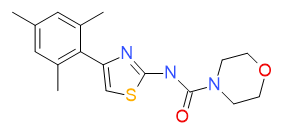|
N-(4-mesityl-1,3-thiazol-2-yl)morpholine-4-carboxamide
An inhibitor of Nek2/Hec1 exhibits significantly improved antiproliferative activity against MB231, MB468, HeLa, and K562 cells (IC50 = 1.6, 4.2, 2.5, and 3.8 µM, respectively)

Chemical Formula: C17H21N3O2S
Molecular Weight: 331.4398
OTAVAchemicals Catalogue Number: 7070707073
CAS Registry Number: 1134986-24-5
Purity: 95% (HPLC)
Ref. 1. Qiu, Xiao-Long; Li, Guideng; Wu, Guikai; Zhu, et al. Synthesis and Biological Evaluation of a Series of Novel Inhibitor of Nek2/Hec1 Analogues. Journal of Medicinal Chemistry (2009), 52(6), 1757-1767
Ref. 2. Bohari, M., Srivastava, H., & Sastry, G. (2011). Analogue-based approaches in anti-cancer compound modelling: the relevance of QSAR models. Organic and Medicinal Chemistry Letters, 1(1), 3.
Abstract 1 : High expression in cancer 1 (Hec1) is an oncogene overly expressed in many human cancers. Small molecule inhibitor of Nek2/Hec1 (INH) targeting the Hec1 and its regulator, Nek2, in the mitotic pathway, was identified to inactivate Hec1/Nek2 function mediated by protein degradation that subsequently leads to chromosome mis-segregation and cell death. To further improve the efficacy of INH, a series of INH analogues were designed, synthesized, and evaluated. Among these 33 newly synthesized analogues, three of them, 6, 13, and 21, have 6-8 fold more potent cell killing activity than the previous lead compound INH1. Compounds 6 and 21 were chosen for analyzing the underlying action mechanism. They target directly the Hec1/Nek2 pathway and cause chromosome mis-alignment as well as cell death, a mechanism similar to that of INH1. This initial exploration of structural/functional relationship of INH may advance the progress for developing clinically applicable INH analogue.
Abstract 2. QSAR is among the most extensively used computational methodology for analogue-based design. The application of various descriptor classes like quantum chemical, molecular mechanics, conceptual density functional theory (DFT)- and docking-based descriptors for predicting anti-cancer activity is well known. Although in vitro assay for anti-cancer activity is available against many different cell lines, most of the computational studies are carried out targeting insufficient number of cell lines. Hence, statistically robust and extensive QSAR studies against 29 different cancer cell lines and its comparative account, has been carried out.
DOI:
-
10.1021/jm8015969
-
10.1186/2191-2858-1-3
Price info:
|
1 MG |
29 EUR |
|
5 MG |
49 EUR |
|
10 MG |
74 EUR |
|
300uL of 10mM solution |
39 EUR
|
|
 HOME
HOME ABOUT
ABOUT
 SERVICES
SERVICES
 PRODUCTS
PRODUCTS
 Targeted Libraries
Targeted Libraries
 Biochemicals
Biochemicals
 RESEARCH
RESEARCH
 DOWNLOADS
DOWNLOADS ORDERING
ORDERING
 CONTACTS
CONTACTS


